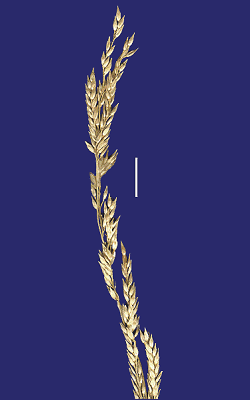Eriochloa crebra S. T. Blake. Proc.
Roy. Soc. Queensland 59: 156 (1948).
Classification. (GPWG 2001) : Subfamily
Panicoideae. Paniceae.
Type of Basionym or
Protologue Information: Australia, Ilfracombe: Blake 11358.
Key references
(books and floras): [1981] M.Lazarides in J.Jessop (ed)., Flora of Central
Australia (478), [2002] D.Sharp & B.K.Simon, AusGrass, Grasses of
Australia, [2006] J.Jessop, G.R.M.Dashorst, F.M.James, Grasses of South
Australia (451), [2008] S.W.L.Jacobs, R.D.B.Walley & D.J.B.Wheeler, Grasses
of New South Wales (263).
Illustrations:
[2006] J.Jessop, G.R.M.Dashorst, F.M.James, Grasses of South Australia (453, fig. 385), [2008] S.W.L.Jacobs,
R.D.B.Whalley & D.J.B.Wheeler, Grasses of New South Wales, 4th edn
(263).
Habit.
Perennial. Culms erect, 35–100 cm tall, 2–5 -noded. Mid-culm nodes glabrous.
Lateral branches simple or sparsely branched. Ligule a fringe of hairs, 0.6–1
mm long. Leaf-blades 4–25 cm long, 2–7 mm wide. Leaf-blade surface smooth,
indumented.
Inflorescence.
Inflorescence compound, a panicle of racemes. Racemes 5–25, 1.5–5 cm long.
Central inflorescence axis 9–25 cm long.
Spikelets.
Spikelets pedicelled. Fertile spikelets 2-flowered, the lower floret barren
(rarely male), the upper fertile, comprising 1 basal sterile florets,
comprising 1 fertile floret(s), without rachilla extension, lanceolate or
ovate, dorsally compressed, 3.7–5.5 mm long.
Glumes. Glumes
thinner than fertile lemma. Upper glume lanceolate or ovate, 3.9–5.5 mm long,
membranous, without keels, 5 -nerved. Upper glume surface indumented. Upper
glume apex muticous or mucronate. Florets. Basal sterile florets 1,
barren, without significant palea. Lemma of lower sterile floret 90 % of length
of spikelet, 5 -nerved.
Fertile lemma 2–3 mm
long, without keel. Lemma apex mucronate. Median (principal) awn 1 mm long overall.
Continental
Distribution: Australasia.
Australian
Distribution: Western Australia, Northern Territory, South Australia,
Queensland, New South Wales.
Northern Territory:
Darwin & Gulf. South Australia: Lake Eyre. Queensland: Burke,
Cook, Darling Downs, Gregory North, Leichhardt, Maranoa, Mitchell, Moreton,
North Kennedy, South Kennedy, Warrego, Gregory South. New South Wales:
North-Western Plains, South-Western Plains, North Far Western Plains.
Notes.
Distinguished from E. procera by the larger spikelets. Some specimens
indicate hybridization with E. pseudoacrotricha.
In tropical heaths,
tropical and subtropical rain forests, Brigalow forests, tropical and
subtropical sub-humid woodlands, semi-arid shrub woodlands, arid and semi-arid
low woodlands, shrub steppe shrublands, acacia shrublands, and arid tussock
grasslands. Occurs over a wide geographical area, and is regarded as a good
forage grass. Flowers Feb.-June.




